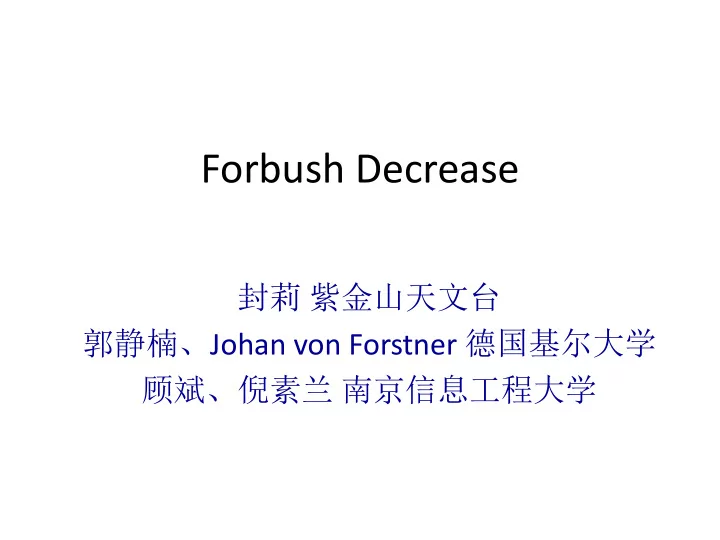

Forbush Decrease 封莉 紫金山天文台 郭静楠、 Johan von Forstner 德国基尔大学 顾斌、倪素兰 南京信息工程大学
Outline 1. Solar modulation of cosmic ray intensity 2. Forbush decrease introduction to CME and its driven shock, and the related Forbush decrease Observational analyses FD simulations FD prediction 3. Sun shadow & CME shadow magnetic field modeling from line-of-sight and vector photosphere magnetic field MHD simulation: e.g. ENLIL model, NSSC COIN-TVD model
Solar cycle: 11/22 years Solar modulation Solar rotation: 27 days Earth rotation: diurnal minimum maximum Phi (MV): Solar modulation parameter from ACE Cosmic Ray Phi: solar modulation parameter Isotope Spectrometer (CRIS)
Forbush decrease “Recurrent” FD: recur with the solar rotation period and are associated with corotating interaction regions ( 27-day variation) “non- recurrent” FD: caused by the passage of transient solar wind structures (CME and its driven shock) FD characteristics: Rapid decrease of the GCR flux within a few hours to 1 or 2 days, Gradual recovery in the coming a few days or 10 days
610 I.G. Richardson, H.V. Cane Two-step Forbush Decrease Fig ure1 Schematic of an interplanetary coronal mass SOHO/LASCO ejection driving a shock ahead of it and the associated variations in the galactic cosmic ray intensity along trajectories that do (A) or do not (B) encounter the ICME (adapted from Cane, 2000 and Zurbuchen and Richardson, 2006). CME shock tracing tracing STEREO/HI1 SOHO/LASCO melmair (1937) using ionization chambers. They were later shown, using neutron monitors (NMs), to originate in the interplanetary medium (Simpson, 1954) and to be of two types: “Recurrent”, which recur with the solar rotation period and are associated with corotating high-speed streams (for a review see Richardson, 2004 and references therein), and “non- recurrent”, caused by the passage of transient solar wind structures associated with coronal mass ejections at the Sun. The focus of this paper is the latter class of events, often termed “Forbush decreases” (FDs), though this term is also used by some researchers to refer to recurrent decreases. The properties and interplanetary drivers of FDs have been reviewed by Cane (2000). Figure 1 shows a schematic of a fast interplanetary coronal mass ejection (ICME), the man- ifestation in the solar wind of a coronal mass ejection at the Sun such as may be observed by coronagraphs, driving a shock ahead of it. Two processes may contribute to the decrease in GCR intensity (see, e.g . , Barnden, 1973a, 1973b; Wibberenz et al. , 1998). The first is a decrease of the GCR radial diffusion coefficient in the turbulent “sheath” between the shock front and leading edge of the ICME. The resulting intensity-time profile is a linear decline during sheath passage followed by a recovery ( cf ., Figure 2 of Wibberenz et al. , 1998). The second process arises from the at least partially closed magnetic configuration of ICMEs as evidenced for example by the presence of bi-directional suprathermal electron flows in many ICMEs suggesting that magnetic field lines are rooted at the Sun at both ends (see, e.g . , Gosling et al. , 1987; Shodhan et al. , 2000). GCRs enter the interior of the ICME as it moves away from the Sun by, for example, cross-field diffusion and gradient and curvature drifts (see, e.g . , Krittinatham and Ruffolo, 2009; Kubo and Shimazu, 2010) such
ICME propagation from 1 AU to 1.5AU Von Forstner et al., 2017, in prep
FD for different CME events Zhao et al. 2016
Key parameters of FD : amplitude,recovery time as a function of median energy Recovery time: Median energy: 2012-Mar-07 event LHAASO: extend the FD study to higher energies
2012-Mar-07 2015-June-21 abnormal case Normal case
2012-Mar-07 event Projections of the propagation of the 3D shock on the solar equatorial plane Mars Earth MSL STA Messenger propagation main direction Venus STB Feng et al., 2012, 2013 ab, 2015ab, 2017
1D Simulation of FD convection diffusion Energy change 1D case Diffusion coefficient and its scale μ Ni et al., 2017, in prep
1D Simulation of FD μ is inversely proportional to V
FD prediction- shock precursor Decrease of cosmic ray intensity in front the shock; have nearly the same rigidity spectrum as the FD. Nagashima et al. 1992
Recommend
More recommend